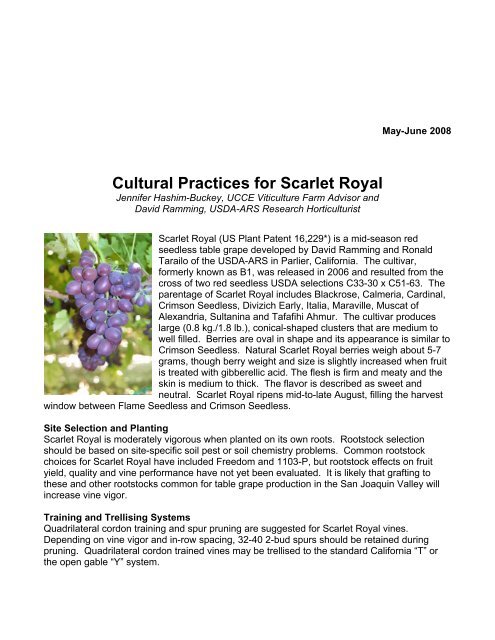98672
Create successful ePaper yourself
Turn your PDF publications into a flip-book with our unique Google optimized e-Paper software.
May-June 2008<br />
Cultural Practices for Scarlet Royal<br />
Jennifer Hashim-Buckey, UCCE Viticulture Farm Advisor and<br />
David Ramming, USDA-ARS Research Horticulturist<br />
Scarlet Royal (US Plant Patent 16,229*) is a mid-season red<br />
seedless table grape developed by David Ramming and Ronald<br />
Tarailo of the USDA-ARS in Parlier, California. The cultivar,<br />
formerly known as B1, was released in 2006 and resulted from the<br />
cross of two red seedless USDA selections C33-30 x C51-63. The<br />
parentage of Scarlet Royal includes Blackrose, Calmeria, Cardinal,<br />
Crimson Seedless, Divizich Early, Italia, Maraville, Muscat of<br />
Alexandria, Sultanina and Tafafihi Ahmur. The cultivar produces<br />
large (0.8 kg./1.8 lb.), conical-shaped clusters that are medium to<br />
well filled. Berries are oval in shape and its appearance is similar to<br />
Crimson Seedless. Natural Scarlet Royal berries weigh about 5-7<br />
grams, though berry weight and size is slightly increased when fruit<br />
is treated with gibberellic acid. The flesh is firm and meaty and the<br />
skin is medium to thick. The flavor is described as sweet and<br />
neutral. Scarlet Royal ripens mid-to-late August, filling the harvest<br />
window between Flame Seedless and Crimson Seedless.<br />
Site Selection and Planting<br />
Scarlet Royal is moderately vigorous when planted on its own roots. Rootstock selection<br />
should be based on site-specific soil pest or soil chemistry problems. Common rootstock<br />
choices for Scarlet Royal have included Freedom and 1103-P, but rootstock effects on fruit<br />
yield, quality and vine performance have not yet been evaluated. It is likely that grafting to<br />
these and other rootstocks common for table grape production in the San Joaquin Valley will<br />
increase vine vigor.<br />
Training and Trellising Systems<br />
Quadrilateral cordon training and spur pruning are suggested for Scarlet Royal vines.<br />
Depending on vine vigor and in-row spacing, 32-40 2-bud spurs should be retained during<br />
pruning. Quadrilateral cordon trained vines may be trellised to the standard California “T” or<br />
the open gable “Y” system.
Productivity and Crop Load Management<br />
Information on commercial production potential has yet to be established given its brief<br />
production history. However, experimental observation and data indicate that mature Scarlet<br />
Royal will yield 1100-1300 10 kg (22 lb.) boxes per acre for quadrilateral cordon, spur-pruned<br />
vines grown on a gable system. Cluster counts prior to bloom ranged from 50-70 per vine and<br />
crop load should be adjusted by thinning to about 40-45 well shaped clusters following berry<br />
set so as not to impede fruit growth. In addition to cluster thinning, it may be necessary in<br />
some years to thin berries due to their naturally large size.<br />
Girdling and Gibberellic Acid<br />
Very limited information has been developed on cultural practices to reduce set and improve<br />
the size of Scarlet Royal grapes. Girdling at berry set to increase berry size is not<br />
recommended on Scarlet Royal vines as previous work has shown that girdling may cause<br />
significant sunburn damage to fruit and may increase astringency in the berry skins. Initial<br />
work on bloom time applications of gibberellic acid (GA) indicate that rates of 2-2.5 ppm<br />
applied at 40%-60% bloom may not be completely effective for loosening the cluster. When<br />
determining optimal rates and timing, its best to observe untreated fruit during the first fruiting<br />
year and then begin with lower rates (2 ppm) and evaluate treatment effects before using<br />
higher rates. GA at the rate of 20 ppm applied at fruit set appears to be effective for increasing<br />
berry size. However, a 40 ppm rate has been shown to reduce return fruitfulness (the<br />
following year). In most cases the reduction may not be of economic importance due to the<br />
cultivar’s highly productive nature. More work is needed to determine GA rates that will<br />
provide consistent effects on cluster thinning and increased berry size.<br />
Color Development<br />
Scarlet Royal grapes color well when grown under a full canopy and do not appear to have the<br />
problems of other red seedless cultivars, like Crimson Seedless and Flame Seedless, if crop<br />
load is properly managed. Ethrel (ethephon) is generally not recommended, as treated fruit<br />
may develop an undesirable purple color in comparison to the deep crimson hue of untreated<br />
fruit. Observations indicate that minimal basal leaf removal and other common canopy<br />
management practices are sufficient to enhance coloration.<br />
Canopy Management<br />
Shoot thinning should be performed on vines when shoot length reaches 8-10 inches. Shoot<br />
positioning should be performed on open gable or other divided canopy systems. Minor leaf<br />
pulling in the fruit zone is generally recommended to facilitate air flow and foliar spray<br />
penetration, and facilitate color development. Shoot trimming or hedging in the row middles<br />
just prior to harvest is typically performed to maintain canopy shape and reduce humidity within<br />
the fruiting region.<br />
Special Problems and Considerations<br />
Scarlet Royal is susceptible to undesirable skin astringency, or bitter flavors if fruit is held too<br />
long on the vine and allowed to become over ripe (>23% soluble solids). Harvest must not be<br />
delayed. It is recommended that harvest begin when berries are well colored near the<br />
capstem and the fruit is sweet (≥17% soluble solids) and well balanced and continue harvest<br />
until soluble solids reach 22% to ensure high quality, palatable fruit.
* Scarlet Royal is exclusively licensed to the California Table Grape Commission and inquiries<br />
regarding availability of Scarlet Royal should be addressed to the commission at 392 W.<br />
Fallbrook, Suite 101, Fresno, CA 93711-6150.<br />
Scarlet Royal grapes on 1.5 year-old vines. Arvin, California. Photo taken 7/24/2007.






